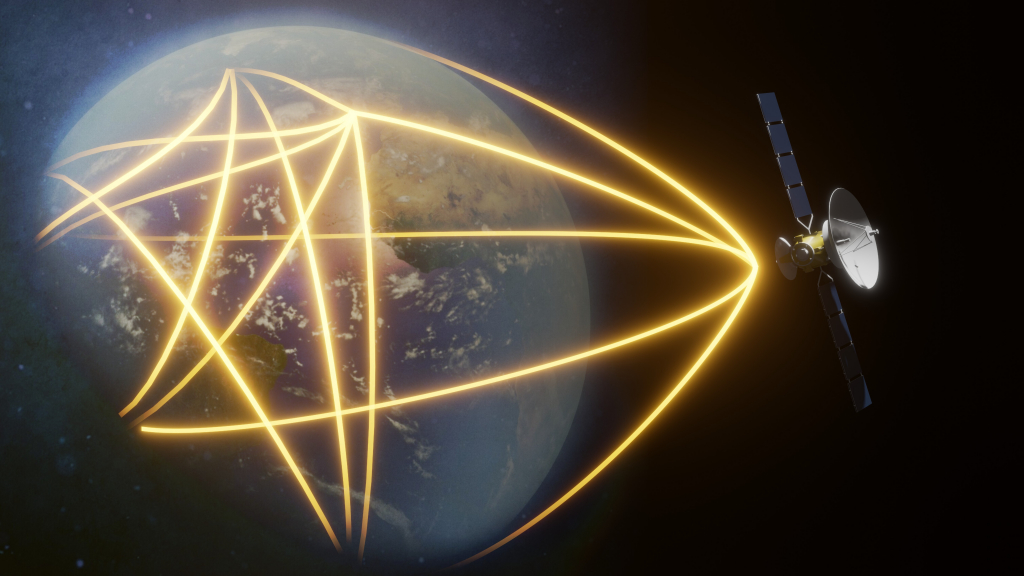AUI will present at the 247th meeting of the American Astronomical Society in Phoenix from January 4-8.
Recent News
ALMA Helps Unmask Monster Black Hole Behind Record-Breaking Cosmic Burst
Astronomers have used the Atacama Large Millimeter/submillimeter Array (ALMA) together with a suite of space- and ground-based telescopes, to study AT 2024wpp, the most luminous fast blue optical transient (LFBOT) ever observed.
Astronomers Make First Radio Detection of Rare Supernova Type, Revealing Secrets of Stellar Death
Astronomers using the U.S. National Science Foundation Very Large Array have captured the first-ever radio signals from a rare class of stellar explosion known as a Type Ibn supernova.
Black Hole Explorer Hopes to Reveal New Details of Supermassive Black Holes

Credit: Joseph R. Farah (LCO/UCSB)
CfA and NSF NRAO combine forces to take the Event Horizon Telescope to space
A new agreement between the Center for Astrophysics | Harvard & Smithsonian (CfA) and the U.S. National Science Foundation National Radio Astronomy Observatory (NSF NRAO) will help the Event Horizon Telescope (EHT) take its next steps – into space.
The EHT made headlines around the world in 2019 after it took the first images of a black hole, and then in 2022, imaged the supermassive black hole at the heart of the Milky Way galaxy. The Black Hole Explorer (BHEX) mission would extend this work by combining several of NRAO’s ground-based radio antennas with a space-based telescope to produce the most detailed images in history. BHEX would allow scientists to reveal the light that orbits the edge of a black hole before it escapes, known as a photon ring.
“This collaboration with NRAO marks a significant step forward in our quest to understand the nature of black holes,” said Dr. Michael Johnson, Principal Investigator for BHEX at the CfA, which has been one of the leaders in the EHT project since its inception. “By extending the EHT to space, we’ll be able to study dozens of black holes and see how they power the brightest engines in the universe.
This partnership, which officially launched this month, aims to push the boundaries of human understanding of black holes and advanced astrophysics research.
“NRAO leads and operates some of the most sensitive radio observatories in the world, making for a perfect partnership with the CfA to make this hybrid radio observatory happen,” said Sara Issaoun, a Submillimeter Array Fellow at the CfA and the BHEX Science Operations Lead. “By combining space-based and ground-based observations, we’ll be able to achieve unprecedented resolution and gain new insights into these cosmic phenomena.”
The NSF NRAO has agreed to explore access to its current and possible future ground-based facilities to serve as ground anchors for the BHEX space-VLBI interferometer. These include the NSF Green Bank Telescope (NSF GBT) the Atacama Large Millimeter/submillimeter Array (ALMA) in which NSF NRAO is a partner, and the proposed Next Generation Very Large Array (ngVLA). The partnership will foster the sharing of knowledge, resources, and staff between the CfA and NSF NRAO. Both institutions will work together to quantify advancements necessary for upgrades to ground based instruments and infrastructure.
“We’re looking forward to using our ever growing expertise in operating state-of-the-art radio facilities and processing and management of high data volumes for this mission,” shared Dr. Tony Beasley, Director of the NSF NRAO, “With the support of the NSF and administration from Associated Universities, Inc., NRAO can position itself as a major partner in the ground network of this unique hybrid observatory.”
The Center for Astrophysics aims to answer humanity’s unresolved questions about the universe. Every day, our scientists are pushing the envelope on what’s possible,” said Dr. Lisa Kewley, Director of the CfA. “We look forward to working with NRAO as longtime leaders in radio astronomy. With this new partnership, together we will redefine the boundary of our knowledge about black holes.”
Dr. Tirupati Kumara “TK” Sridharan, ngVLA Lead Calibration Scientist and BHEX Antenna Lead at NSF NRAO added, “This collaboration leverages the strengths of the two institutions, allowing us to push the boundaries of radio astronomy and enable groundbreaking discoveries in astrophysics and fundamental physics.”
The NSF NRAO plans to lead negotiations with international partners of the Atacama Large Millimeter/submillimeter Array (ALMA) as another anchor for BHEX.
About NRAO
The National Radio Astronomy Observatory (NRAO) is a facility of the U.S. National Science Foundation, operated under cooperative agreement by Associated Universities, Inc.
About CfA
The Center for Astrophysics | Harvard & Smithsonian is a collaboration between Harvard and the Smithsonian designed to ask—and ultimately answer—humanity’s greatest unresolved questions about the nature of the universe. The Center for Astrophysics is headquartered in Cambridge, MA, with research facilities across the U.S. and around the world.
More about BHEX
BHEX is currently under development as a 2025 Astrophysics Small Explorer Mission proposal for NASA, to launch in 2031. BHEX is led by the CfA, with partners including the University of Arizona, MIT Haystack Observatory, MIT Lincoln Laboratory, Vanderbilt University, the National Radio Astronomy Observatory, and Lockheed Martin.
This news article was originally published on the NRAO website on December 12, 2024.
Recent News
AUI to Attend AAS 247 Conference
AUI will present at the 247th meeting of the American Astronomical Society in Phoenix from January 4-8.
ALMA Helps Unmask Monster Black Hole Behind Record-Breaking Cosmic Burst
Astronomers have used the Atacama Large Millimeter/submillimeter Array (ALMA) together with a suite of space- and ground-based telescopes, to study AT 2024wpp, the most luminous fast blue optical transient (LFBOT) ever observed.
Astronomers Make First Radio Detection of Rare Supernova Type, Revealing Secrets of Stellar Death
Astronomers using the U.S. National Science Foundation Very Large Array have captured the first-ever radio signals from a rare class of stellar explosion known as a Type Ibn supernova.
